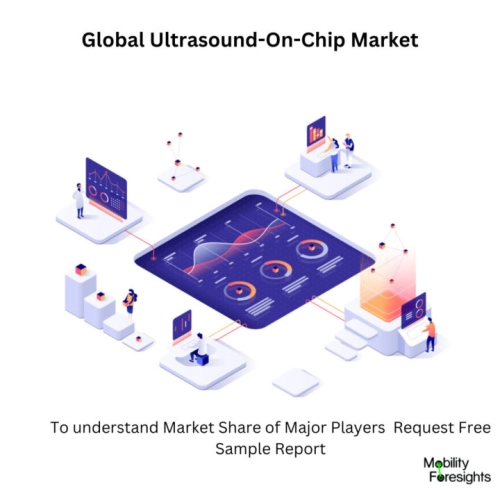
- Get in Touch with Us

Last Updated: Apr 25, 2025 | Study Period:
INTRODUCTION OF ULTRASOUND-ON-CHIP MARKET
Ultrasound-on-chip technology is a breakthrough in medical imaging that uses a single chip to produce ultrasound images. The technology uses a small chip containing electronic transducers, which are tiny electrodes that can generate and detect sound waves.
These transducers convert electrical signals into sound waves, which then bounce off of various tissues in the body and return back to the chip. The chip then converts the returning sound waves into an image that can be viewed on a computer screen.
Ultrasound-on-chip technology allows for much greater resolution and accuracy than traditional ultrasound imaging. This is because the chip is able to detect sound waves at a much higher frequency, giving it greater detail and clarity.
Additionally, the chip is much smaller and more portable than traditional ultrasound machines, making it easier to use and transport. Finally, the technology is much less expensive than traditional ultrasound machines, making it a more accessible option for medical care.
Ultrasound-on-chip technology has a wide range of potential applications in medicine. It can be used to diagnose and monitor a variety of medical conditions, such as monitoring the progress of an unborn baby, detecting tumors, and assessing the health of organs.
It can also be used for minimally invasive procedures, such as ablation and biopsy. With the continued development of this technology, ultrasound-on-chip has the potential to revolutionize medical imaging and make it more accessible and affordable.
ULTRASOUND-ON-CHIP MARKET SIZE AND FORECAST

The Global Ultrasound-on-chip market accounted for $XX Billion in 2022 and is anticipated to reach $XX Billion by 2030, registering a CAGR of XX% from 2024 to 2030.
Butterfly Network and Forest Neurotech have agreed to Collaborate on Next-Generation Brain Computer Interfaces Using Ultrasound-on-Chip Technology. A model collaborator who supports Butterfly Garden's mission is Forest Neurotech.
In order to foster and accelerate innovation that fully realises the innovative chip technology of Butterfly through new applications and in adjacent markets, they have opened their imaging platform for co-development.
This agreement achieves precisely that by introducing the chip into the neurotech implantables area. They are excited to take this adventure alongside Butterfly Network, whose innovative Ultrasound-on-Chip technology is essential to making possible their cutting-edge method of brain stimulation and imaging with minimal invasiveness.
Butterfly is the ideal partner to help them realise the objective of creating the first implanted, whole-brain neural interface in history because we both have a love for innovation and semiconductor-enabled healthcare technology.
This development comes after Butterfly announced that it was launching Butterfly Garden to help work with AI startups, software developers, or manufacturers of medical devices to help them create new applications using its leading imaging technology.
Ultrasonic-on-Chip technology from Butterfly is extremely ideal for a range of ultrasonic sensing use cases, including future implantables, because it can function at a wide range of frequencies, has significant programming freedom, and is compact in size.
With the MATRIX linear transducer 4G CMUT, Hitachi unveiled the first chip-based ultrasonic transducerâa capacitive micromachined ultrasound transducer (CMUT). manufacture did not grow as quickly as many had anticipated, despite initial demand, because of issues with image quality and manufacture. The transducer's penetrating capabilities were lost when it switched to a silicon chip.
The transducer could scan the whole body, but it could only do so at one depth, which was insufficient for a number of medical procedures and inferior to specialised piezoelectric transducers. Furthermore, because the technology was novel, mass-production manufacturing procedures for the transducers had not yet been established.
ULTRASOUND-ON-CHIP MARKET THIS REPORT WILL ANSWER FOLLOWING QUESTIONS
| Sl no | Topic |
| 1 | Market Segmentation |
| 2 | Scope of the report |
| 3 | Abbreviations |
| 4 | Research Methodology |
| 5 | Executive Summary |
| 6 | Introduction |
| 7 | Insights from Industry stakeholders |
| 8 | Cost breakdown of Product by sub-components and average profit margin |
| 9 | Disruptive innovation in the Industry |
| 10 | Technology trends in the Industry |
| 11 | Consumer trends in the industry |
| 12 | Recent Production Milestones |
| 13 | Component Manufacturing in US, EU and China |
| 14 | COVID-19 impact on overall market |
| 15 | COVID-19 impact on Production of components |
| 16 | COVID-19 impact on Point of sale |
| 17 | Market Segmentation, Dynamics and Forecast by Geography, 2024-2030 |
| 18 | Market Segmentation, Dynamics and Forecast by Product Type, 2024-2030 |
| 19 | Market Segmentation, Dynamics and Forecast by Application, 2024-2030 |
| 20 | Market Segmentation, Dynamics and Forecast by End use, 2024-2030 |
| 21 | Product installation rate by OEM, 2023 |
| 22 | Incline/Decline in Average B-2-B selling price in past 5 years |
| 23 | Competition from substitute products |
| 24 | Gross margin and average profitability of suppliers |
| 25 | New product development in past 12 months |
| 26 | M&A in past 12 months |
| 27 | Growth strategy of leading players |
| 28 | Market share of vendors, 2023 |
| 29 | Company Profiles |
| 30 | Unmet needs and opportunity for new suppliers |
| 31 | Conclusion |
| 32 | Appendix |